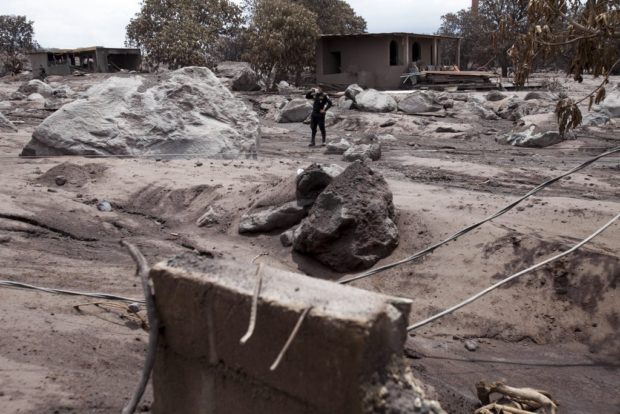
A police officer pauses during a patrol near the Volcan de Fuego or “Volcano of Fire” disaster zone, in San Miguel Los Lotes, Guatemala, Thursday, June 7, 2018. Guatemala’s national disaster agency suspended search and rescue efforts at the zone devastated by the eruption of the Volcano of Fire, saying climatic conditions and still-hot volcanic material makes it dangerous for the rescuers. (AP Photo/Moisés Castillo)
SAN MIGUEL LOS LOTES, Guatemala — Rescuers suspended on Thursday search and recovery efforts at villages devastated by the eruption of Guatemala’s Volcano of Fire, leaving people with missing loved ones distraught and prompting some to do the risky work themselves with rudimentary tools.
Conred, the national disaster agency, said climatic conditions and still-hot volcanic material were making it dangerous for rescuers, and it was also taking into account the fact that 72 hours had passed since Sunday’s eruption.
That was the window beyond which officials earlier said it would be extremely unlikely to find any survivors amid the ash, mud, and other debris that buried homes up to their rooftops.
“It rained very hard yesterday. … The soil is unstable,” said Pablo Castillo, a spokesman for national police.
Guatemalan prosecutors ordered an investigation into whether emergency protocols were followed properly, as many residents were caught with little or no time to evacuate.
Troublesome downpours and more volcanic activity had been hindering searches but when teams have been able to work in the hardest hit areas, the death toll has continued to tick upward. The official number of confirmed dead was raised by 10 to 109 in the early evening, with about 200 more believed to be missing.
Oscar Chavez trekked over a mountain with his father and younger brother to search for his brother Edgar, sister-in-law Sandra, and 4-year-old nephew Josue in the hamlet of San Miguel Los Lotes, which was almost entirely wiped out by the volcanic flows. They have not been heard from since the eruption.
“We looked for them in shelters, hospitals, everywhere, but we did not find them,” said Chavez, 34, wiping a tear from his eye as the others used sticks and bits of broken boards to dig at the collapsed, ash-filled home. “So, better for us to come here.”
A group of police officers saw what the family was doing and came to lend shovels and help with the digging.
A dozen other families also arrived to search the homes. Before Thursday, they had been unable to access the area while rescuers were working.
Chavez’s younger brother was angry that there were no longer any disaster workers at the scene while a little way downhill heavy machinery was being used to clear a road blocked by ash. And he directed his ire at President Jimmy Morales.
“They are cleaning the highway — the president has commitments to businesspeople. … But here, since the people have nothing to offer him, he leaves this part as a burial ground,” said Francisco Chavez, a 29-year-old accounting student.
At a shelter set up in a school in the nearby city of Escuintla, workers fastened colorful ID bracelets on the wrists of people, who are among several thousand displaced by the eruption.
Children who survived to the Volcan de Fuego or “Volcano of Fire” eruption laugh as a clown performs near a shelter in Alotenago, Guatemala, Thursday, June 7, 2018. Guatemalan prosecutors ordered an investigation into whether emergency protocols were followed properly, as many residents were caught by the eruption with little or no time to evacuate. (AP Photo/Rodrigo Abd)
Nohemi Ascon, 41, is the aunt of six children between the ages of 1 and 8 who died in Los Lotes. A photograph taken shortly after the disaster showed their bodies huddled together on a bed in the corner of a room, covered in white ash, and blood.
Ascon said other family members were still unaccounted for.
“My father, my mother, my sisters (were) there,” she said, upset over rescuers’ decision to suspend their search. “It is their job. It is not right that they leave them there. They should get them out so we can take them to the cemetery.”
The United States announced it was sending emergency aid, including financial resources, to help meet food, water, and sanitation needs.
Washington also dispatched aircraft to help transport burn victims to Florida and Texas. Late Wednesday a US Air Force C-17 carried six Guatemalan children who were badly burned for treatment at the Shriner’s Hospital in Galveston, Texas.
White House spokeswoman Sarah Huckabee Sanders offered “deepest condolences” to victims and said the aid was being provided at the request of the government of Guatemala.
At a cemetery in Escuintla, relatives of Sandra Orizabal, 37, buried her in a white coffin next to the grave of her husband, who was interred the previous day.
All told, 18 members of the family died or disappeared in the disaster. Orizabal was just the fifth to be found and laid to rest.
“I am burying my daughter with great pain,” said Pedro Orizabal, her father. “May God bless all the family that is still standing.”
Sandra Orizabal was buried hurriedly and without the usual wake on the order of health authorities.
Workers have already dug a row of additional graves at the lush green cemetery, ready and waiting for whoever comes next. /kga